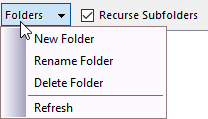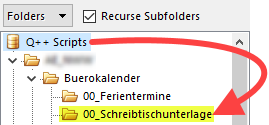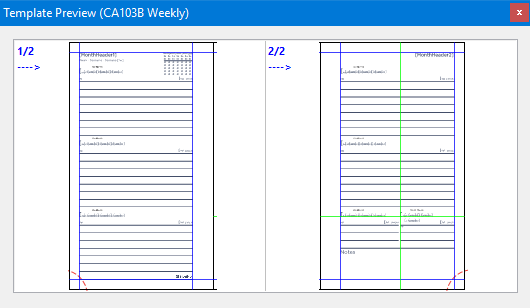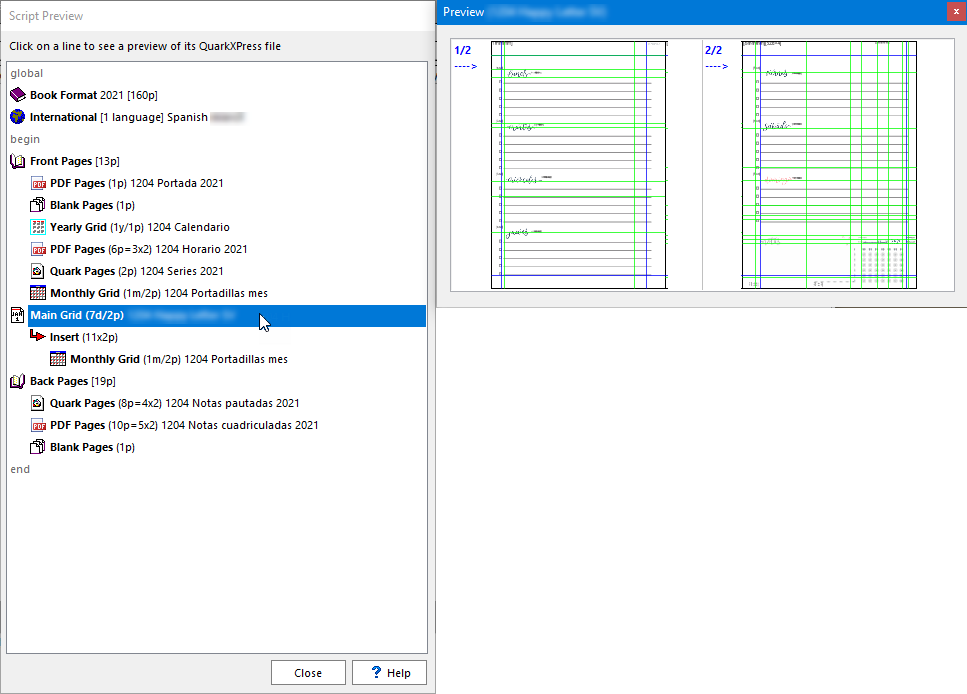
➢To open the Scripts Explorer, select the corresponding menu item, from the scripts menu, or use the corresponding toolbar icon, as shown on the right.
The left side of the Scripts Explorer contains the Script Folders, and the right side contains the scripts that belong to the folder selected on the left (and its sub-folders, if the Recurse Subfolders option, discussed below, is checked).
Script Folders

Clicking on the Directories button displays a drop-down menu allowing you to create new folders, rename the currently selected folder, or delete the currently selected folder.
The refresh menu item is used to reload, from the database server, the currently displayed list of Script folders (if another user has made changes to the scripts folder hierarchy since you opened the Scripts Explorer).
The Recurse Subfolders option means that the list of scripts, to the right, will include all the scripts contained in the current folder, as well as all the scripts contained in any of the sub-folders of the current folder.
Scripts
You can sort, filter and group, as well as select multiple scripts in the list of scripts on the right of the scripts explorer using the advanced data grid.
The scripts menu of the Scripts Explorer contains the following menu items:
Open |
Use the Open menu item to close the Scripts Explorer and open the currently selected script in the main window. You can also open the currently selected script by pressing F2 (the same shortcut as in the main window), or by double-clicking on it. |
Execute (generate diary) |
Use the Execute menu item to close the Scripts Explorer, open the currently selected script in the main window, and then execute it (generate the corresponding diary). You can also execute the currently selected script from within the Scripts Explorer by pressing F9 (the same shortcut as in the main window). |
Select containing folder |

This is useful if, as in the example on the right, you are displaying all the scripts of the database, by selecting the Q++scripts root and having the recurse subfolders option on.
In such cases, all the scripts are mixed together and the Select Containing Folder menu item is the way to navigate to the exact folder that contains the selected script.
Note that using the Select Containing Folder menu item makes no sense if the recurse subfolders option is not activated. |
Copy |
Use the Copy menu item to copy one or more selected scripts (a dialog will come up asking you for the destination path).
You can also copy multiple scripts in the Scripts Explorer by dragging them with the mouse to the destination folder. Note that copying files preserves their names, and therefore you cannot copy files from and to the same directory, using drag and drop. If you wish to make a copy of a Script in the same directory, you must use the Copy menu item. |
Move |
Use the Move menu item to move one or more selected scripts (a dialog will come up asking you for the destination path).
You also can move multiple scripts in the Scripts Explorer either by dragging them with the mouse to the destination folder. |
Rename |
Use the Rename menu item to rename the currently selected script in the Scripts Explorer. |
Use the Delete menu item to delete one or more selected scripts in the Scripts Explorer. |
|
Unlock |
Use the Unlock menu item to unlock a script which might be incorrectly reported as locked in message 179410. |
|
To preview the script lines and structure of a Script, right-click on a Script and select Preview Script, from within the Scripts Explorer.
A dialog appears with the list of script lines of the current script, displayed in essentially the same manner as in the script editor.
Clicking on any of the script lines that refers to a QuarkXPress document displays a bitmap preview of that QuarkXPress document.
You can also preview a script more fully, including its page sequence and the value of each token on each page, using the full script preview. |
|
Preview Main Grid |

The preview displayed here is the same as you would get if using the Preview Script menu item (above) and selected the main grid in the preview window, or the Preview All Grids menu item (below).
➢If you only need to see a preview of the main grid of a script, then this is the fastest option as it involves only one click, and, more importantly, the preview of the main grid is already in memory, and therefore access to it is much faster than having the system search the script and display all its DiaryGridLines, as happens when using either of the Preview Script or Preview All Grids menu items. |
Preview All Grids |

The sub-menu items follow the order of the script lines in the script editor and the main grid is displayed in bold uppercase. |
Open Used Files |
Use the Open Grids menu item to open any of the QuarkXPress files used by the currently selected script, using QuarkXPress, depending on the format of the file. |
Open Output File |
Use the Open Output File menu item to open the output file of the currently selected script, using QuarkXPress, depending on the format of the file. |
Copy Used Filenames |
Use the Copy Used Filenames menu item to copy onto the clipboard, the full paths or just the file names of all the QuarkXPress files used by the all currently selected scripts (this function works with multiple selections of scripts). |
Use the Re-scan Used Files menu item to batch re-scan the templates of the currently selected script, using QuarkXPress, depending on the format of the file. |
Except for the possibility of viewing the scripts' main properties, without opening them, there are specific dialogs to perform all the actions the Scripts Explorer is capable of. One advantage of the Scripts Explorer over the function specific dialogs, is that you can copy, move and delete multiple scripts, without having to open them.
Topic 108066, last updated on 09-Sep-2024

